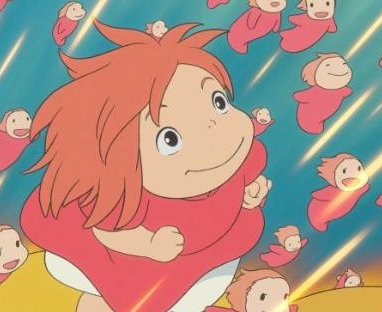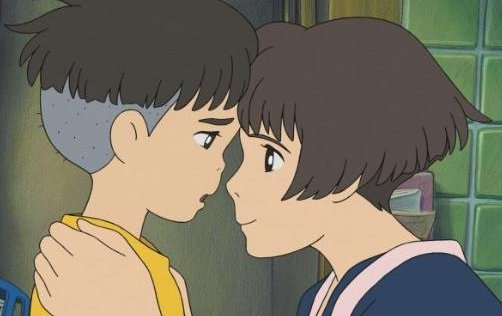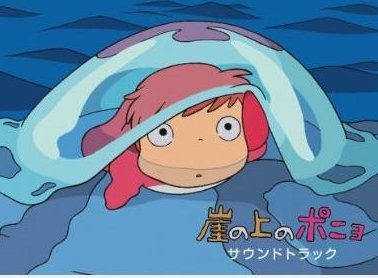In recent years, animation director Hayao Miyazaki and his company Studio Ghibli have developed a growing fanbase in the United States, despite lackluster box office sales. Often referred to as “the Walt Disney of Japan,” Miyazaki’s popularity in the Western world is largely due to the actual Walt Disney Company, which distributes his films in the U.S., as they do with Pixar (which is also connected to Ghibli through Miyazaki’s close friendship with John Lasseter). The deal between Studio Ghibli and Walt Disney has seen all but two major Ghibli films released on DVD in the U.S. within the last decade (the only exceptions being Isao Takahata’s Only Yesterday and Goro Miyazaki’s Tales from Earthsea), with limited theatrical releases of Princess Mononoke, the Academy-Award-winning Spirited Away, and Howl’s Moving Castle.
The latest offering from Miyazaki and Studio Ghibli is Ponyo, a fish-out-of-water tale that evokes Disney’s The Little Mermaid, Pixar’s Finding Nemo, and Miyazaki’s early classic My Neighbor Totoro, while also incorporating many other elements of both Western and East Asian influence. Ponyo was released in Japan last summer and now makes its U.S. debut in both dubbed and subtitled versions (where available). As with other Disney-Ghibli collaborations, the English dub which was screened for this review features a Hollywood cast that includes Liam Neeson, Tina Fey, Matt Damon, Cate Blanchett, Noah Cyrus, and Frankie Jonas.
The film opens with a sea wizard (voiced by Liam Neeson) using his magic to keep various underwater creatures under control. While he is thus occupied, a tiny red fish with a human face escapes and hitchhikes on the back of a jellyfish. After drifting for a long time, she gets tangled in the trash polluting the ocean and ends up trapped in a glass bottle. She makes her way to the shore near a seaside cliff, where a five-year-old boy, Sosuke (Frankie Jonas), discovers and frees her. He places her carefully in a green plastic bucket of water, names her Ponyo, and promises to take care of her.
It isn’t long before Ponyo’s father, the sea wizard Fujimoto, arrives on land in pursuit of his wandering daughter “Brunhilde.” His minions of “wave spirits” manage to take her from Sosuke, leaving him disconsolate for having failed to protect her. Back in Fujimoto’s underwater home, Ponyo (Noah Cyrus) rejects the name he’s given her and says she loves Sosuke. Fujimoto is completely disgusted by her desire to become human, since people have filled th e water with garbage, but her magic is stronger than he thought—she surprises him by growing hands and feet on her own. It is all he can do to contain her in a bubble and force her back into her original shape, before storming off to seek her mother’s help. In his absence, Ponyo’s little sisters free her and she steals some of her father’s magic to escape once again and take human form. Thus the real adventure begins, as she goes in search of Sosuke and learns what it’s like to live on land.
e water with garbage, but her magic is stronger than he thought—she surprises him by growing hands and feet on her own. It is all he can do to contain her in a bubble and force her back into her original shape, before storming off to seek her mother’s help. In his absence, Ponyo’s little sisters free her and she steals some of her father’s magic to escape once again and take human form. Thus the real adventure begins, as she goes in search of Sosuke and learns what it’s like to live on land.
If this seems like a simplistic story, it is. The full Japanese title is Ponyo on the Cliff by the Sea, which gives it a romantic, fairy tale flavor along the lines of the Hans Christian Andersen story on which it is loosely based. This is the first Miyazaki film since My Neighbor Totoro to feature such young protagonists; the behavior of Ponyo as a human girl is reminiscent of Mei, with Sosuke assuming the protective role of the older sister Satsuki in Totoro, even though he’s the same age as Ponyo. Sosuke is a mature little boy who takes on adult responsibilities, such as comforting his mother while his father is at sea for long periods of time. He doesn’t even have time to play with other children once he’s dedicated himself to Ponyo; after being rebuffed, a little girl in his school comments, “How can you be busy? You’re five!”
 As in Totoro, Sosuke is practically being raised by a single parent, Lisa (Tina Fey). Even while his young mother is busy working at the nursing home and pining for her absent husband, she takes the time to encourage Sosuke’s playful imagination. Her loving relationship with her son and quirky attitude are a pleasure to watch. When confronted with Ponyo’s undeniable magic, she only comments, “Life is mysterious and amazing,” before accepting it at face value. This observation perfectly captures the essence of the movie, in which something as mundane as a bowl of instant ramen noodles can be a magical experience for a little girl having them for the first time.
As in Totoro, Sosuke is practically being raised by a single parent, Lisa (Tina Fey). Even while his young mother is busy working at the nursing home and pining for her absent husband, she takes the time to encourage Sosuke’s playful imagination. Her loving relationship with her son and quirky attitude are a pleasure to watch. When confronted with Ponyo’s undeniable magic, she only comments, “Life is mysterious and amazing,” before accepting it at face value. This observation perfectly captures the essence of the movie, in which something as mundane as a bowl of instant ramen noodles can be a magical experience for a little girl having them for the first time.
Ponyo is a simple movie with simple messages about complicated things like love, because when you’re five years old, everything is purer, more innocent, and seems like it could last that way forever. Miyazaki excels at reminding us what it’s like to be that age, when problems really can be solved if we just want it enough. The immediate and strong feelings Sosuke and Ponyo share, which defy their inherent differences, are paralleled by the realities of Lisa’s relationship with her husband Koichi (Matt Damon). He belongs to the sea as much as Ponyo does, often communicating with his family via Morse Code on Aldis lamps. As much as Lisa loves and misses Koichi, she sometimes hates him for being away for so long. Sometimes love isn’t enough, a lesson that Sosuke and Ponyo are a long way off from learning.
There is no real villain in this piece. Though the stakes are no less than the fate of the world, they’re also more about the linked fates of Ponyo and Sosuke. We’re confined to a microcosmic, fishbowl view of their problems, where disastrous events are merely inconveniences or a chance for adventure, more enchanting and wondrous than frightening. Consequently, it seems Ponyo might be better suited for young audiences and wide-eyed adults, though it falls just short of recapturing the youthful spirit of the even more simplistic My Neighbor Totoro. This script is perhaps the weakest of Miyazaki’s efforts, but he has at least toned down the environmentalist agenda, and the film is peppered with amusing and heartwarming moments that more than make up for its flaws. As with many children’s films, if you bring in the cynicism of old age, it may not hold up to scrutiny, but it should still be a delight for children. (Be warned that despite its G-rating, some of the bizarre images and events may be disturbing to impressionable kids.)
The English script produced by Kathleen Kennedy and Frank Marshall is reportedly less faithful than usual to the Japanese original, in an effort to make the film more marketable for U.S. audiences. If you’ve seen both versions, please comment and let us know how they differ. Some of the nuances of the film may have been lost in the translation, and may explain the plot issues that seemed poorly developed. Nevertheless, Ponyo is well worth seeing on the big screen if you’re lucky enough to find it in a theater near you, whether subtitled or dubbed. The hand-drawn cels are stunning and rare in these CGI, 3-D days of animation, and the musical score by Ghibli veteran Joe Hisaishi are hauntingly beautiful.
Ponyo will be released in select U.S. theaters on August 14th, 2009.
Eugene Myers has published short fiction in a variety of print and online zines (writing as E.C. Myers). He is a graduate of the Clarion West Writers Workshop and a member of the writing group Altered Fluid. When he isn’t watching Star Trek, he reads and writes young adult novels.










